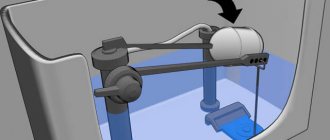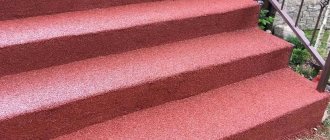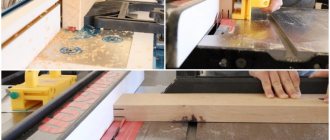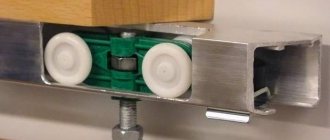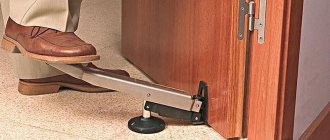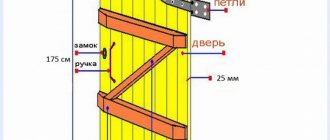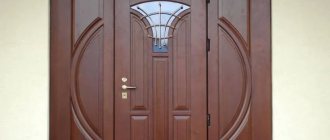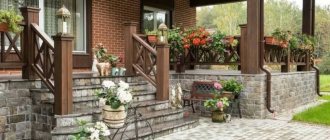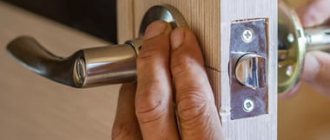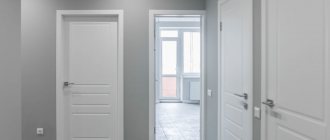You have finally completed the renovation of your home by installing a steel front door. However, in the very first cold season, your joy was overshadowed by the formation of streams of water on the door - it constantly sweats, begins to deform and change its shape, the puddles in the hallway were clearly not intended as a design element. If your plans do not include constant general cleaning of the hallway and replacement of expensive doors every 3-5 years, you will have to take measures. What to do if the front door sweats? Read detailed instructions on how to remove condensation and prevent its occurrence.
Causes of condensation accumulation
The maximum possible moisture content in the air, or absolute humidity, depends on temperature. As the temperature rises, the absolute humidity increases, and vice versa. When a warm zone collides with a cold zone, the temperature drops and excess moisture, exceeding the level of absolute humidity, passes from a vapor state to a liquid state in the form of droplets - condensation is formed.
The temperature at which steam begins to condense is called the dew point. As relative humidity increases, that is, the percentage of moisture relative to absolute humidity, the dew point moves closer to the actual temperature and is the same as at 100 percent humidity. The intensity of condensation increases with increasing humidity in the warm zone and, accordingly, the dew point, as well as the temperature difference between the warm and cold zones. Moisture condensation continues until an acceptable decrease in relative humidity is achieved or until contact with a cold surface is removed.
For this reason, the formation of condensation is especially noticeable in winter, since in summer the temperature inside and outside is not very different. Places and surface areas in contact with the street - the front door, windows, ventilation pipes in the roof area, corner joints of walls and ceilings, cracks and loose junctions of structures - are problematic due to constant condensation. For a metal entrance door, the boundary between cold and heat, on which condensation is deposited, is the internal surface, cooled due to the presence of cold bridges (frame, stiffeners, door frame).
Another reason for the formation of condensation is oversaturation of air with water vapor, for example, in a steam room, bathroom or kitchen during long-term cooking. When over-humidified air and cold surfaces combine, the effect of double condensation occurs.
Consequences of inaction
If owners do not pay attention to the formation of condensation, this will lead to:
- Serious freezing of the canvas.
- Increased heat loss. Such a door will transfer all the heat outside.
- Deformations of the door frame, slopes and leaf. As a result: while saving on eliminating the cause of condensation, you will have to spend money on a new entrance door. Is it worth it - you decide?
Why is condensation dangerous?
Visually, a door with dripping drops of moisture does not look very aesthetically pleasing. When the surface freezes strongly, condensation turns into frost and ice. Condensation makes the air drier, worsening the indoor climate.
Draining moisture enters the keyhole or the lower grooves for the vertical anti-removal pins. If it freezes, you may find that the door simply cannot be opened.
Due to the moistening of the surface, corrosion, rust stains, fungus, and rotting of adjacent wooden parts of the structure form. You regularly have to wipe away any moisture that flows down and remove mold. However, any cleaning only eliminates the consequences; for effective control it is necessary to eliminate the cause.
Professional products
Professional products include special formulations from the Cilit, Pronto, Mister Muscle and other well-known brands. They should be applied according to the instructions on the packaging.
Polishes (Pronto, Laska, etc.) will help get rid of fingerprints, grease stains and dirt without leaving streaks on the doors. The point is the professional composition of the polish: during cleaning the product does not penetrate inside, the wooden surface almost does not get wet and the material does not swell. Using polish, you can wash varnished wooden doors without fear of damaging the varnished coating.
There are many similar professional products designed specifically for coating care, which can be found on the shelves of supermarkets and hardware stores. It is only important to choose the right product that is suitable for a specific door covering.
Ways to get rid of the problem
The choice of a specific method to prevent the formation of condensation depends on whether the door has already been installed or is just about to be installed. Entrance doors to a private house, in addition, require more serious protection than doors to an apartment, since there is a greater difference between the internal and external temperatures. It is generally not recommended to install a metal entrance door to the bathhouse due to the effect of double condensation; the crowns will rot.
Ways to prevent condensation:
- door with thermal break;
- door with heated frame;
- door with decorative overlays made of moisture-resistant MDF panels;
- solid wood door;
- double doors;
- large vestibule;
- household dehumidifier;
- ventilation.
Door with thermal break
The main idea of a door design with a thermal break is to remove all cold bridges using thermal insulation materials. The outer and inner metal surfaces of the door leaf are separated from each other by an insulating gasket, a similar situation with door handles. The door frame (lutka) also consists of two circuits with an insulator between them. Foil-coated isolon, cork and other materials are used as insulators. There are no stiffening ribs or a door peephole.
Doors with a thermal break use only anti-freeze lever-type locks or cylinder locks with a short cylinder and a long rod. Keyholes are only present from the outside, so the possibility of closing from the inside is excluded, with the exception of the “night watchman” rotary bolt.
Heated door frame
An electric heating cable with a safe voltage of about 12 volts is laid in the cavity of the door frame. If the door is already standing, the cable is laid in a metal cable channel attached to the box or a specially punched groove in the wall. To automatically maintain the temperature, a thermostat is installed, the value is set at a level above the dew point.
Door with decorative overlays made of moisture-resistant MDF panels
Decorative panels made of moisture-resistant MDF boards of maximum thickness (at least 16 mm) with PVC coating or varnished are installed on the door leaf. A decorative overlay made of similar MDF panels or solid wood is also attached to the metal box. For an apartment, an internal lining is usually sufficient; for a private house, internal and external linings are required, but they do not always save, so it is better to combine this option with other methods or choose another one.
Solid wood door
A wooden front door is not very popular these days, but some people still use it. Due to significantly lower thermal conductivity compared to metal, a wooden door conducts heat very poorly, which prevents condensation. The only danger is posed by possible gaps in places where there is a loose connection to the door frame. To avoid them, a seal is attached along the contour of the box.
Double doors
If the thickness of the wall allows, install double doors with a small air gap between them, creating a mini vestibule. The internal door is wooden, with a seal, but preferably made not from solid wood, but from MDF with honeycomb filling; it conducts less heat. When entering and exiting the street, frosty air with low relative humidity enters such a mini-vestibule, which then warms up, so condensation does not form.
Large vestibule
In a private house, instead of double doors, you can make an extension in the form of a large external vestibule-veranda, but this option requires more serious investment.
Household dehumidifier
A dehumidifier removes excess moisture from the air, preventing it from settling. At the same time, this method is acceptable only if the air in the room is excessively humidified and the humidity can be reduced to a comfortable level.
Ventilation of the room
Many have noticed that very often condensation appears with the onset of the first frosts, and then decreases or disappears. This is due to the fact that in the process of air exchange with the street, the indoor air is replaced with drier air. Therefore, as a temporary measure, it is quite acceptable to simply open the window and ventilate the room to reduce temperature and humidity.
Cold surfaces are an undesirable attribute of a residential building; they will definitely sweat. And although condensation is unpleasant, and its appearance leads to undesirable consequences, it can and should be dealt with. But for an effective fight, it is worth showing forethought and carrying out preparatory measures in advance.
Additional measures
As additional measures to protect against condensation, you can try the following tips:
- install a canopy or canopy over the front door. It will partially prevent direct contact of snow or rain on the outer door leaf;
- when buying a new door, pay attention to whether it is coated with a special treatment - polymers that are resistant to temperature changes and precipitation;
- make a vestibule, and install a second door made of wood or plastic, but not metal. Then condensation will not appear, since the temperature difference will not be so large. Heat and humid air from living rooms will not flow into the corridor;
- if there is no vestibule and there is no way to make one, then install small heating devices or heaters in the corridor. They will heat the door, slopes and frame, preventing the appearance of water drops.
What can harm?
These products may damage the surface:
- Household chemicals containing acids and ammonia.
- Gasoline products. If there is glass on the door, then rainbow stains will remain on it. Gasoline can damage a laminated surface, leaving a scorched spot on it.
- Alkaline compounds.
- Abrasive cleaning products.
When cleaning doors, you should first wipe it with a clean damp cloth and then with a dry one. Powders, hard brushes and scrapers can damage the surface. Metal elements and fittings can be wiped with soapy water and then dried with a soft cloth. When cleaning and removing stains on doors, do not use fluffy fabrics - it is better to give preference to soft, lint-free wipes.
Recommendations from experts
So that during operation you do not have questions to the manufacturers about why condensation forms in cold weather, experts recommend taking into account the following points when placing an order:
- Separately discuss and order insulation of not only the door itself, but also the frame.
- Refuse to install a peephole in the door facing the street.
- Do not install locks with vertical bolts on such a door or do not connect drive rods in cold weather.
Briefly about the main thing
It is possible to correct most of the various violations in the operation of the door without the involvement of specialists and unnecessary costs, since all procedures are not difficult to perform.
Incorrect installation or inaccurately selected dimensions will require urgent intervention to return the door to its original state. Sagging, too tight door shutter or loose closing become reasons for door adjustment.
There are adjustments of vertical or horizontal type, as well as manipulations to correct the pressure of the sash.
To prevent disturbances in the functioning of the door, install a microlift, a door opening limiter, and try to avoid too sudden openings or closings.
Repairing the door yourself may take a little longer, since you will need to master adjusting the door leaf using keys.
Vertical adjustment
Doors with a tilt-and-turn system have a rather complex design. But they are easy to adjust. To ensure the correct vertical position of the door leaf, you need to operate the corresponding adjusting screws, which allow you to lower or raise the structure.
The procedure for adjusting a plastic door, entrance or balcony:
- Identify the cause of the problem and prepare tools (hexagon or special star wrench). It is important that the hinges have a consistent appearance, otherwise making adjustments will be problematic, if not impossible.
Hexagonal star key Source prom.st
Traditional methods for combating yellowness on plastic frames
Experts recommend using ordinary soap or its liquid version when washing window structures. A small piece of soap must be grated or cut and poured with a glass of boiling water. Let it brew and stir. The composition must be applied to plastic frames, left for 30-40 minutes, then rub the yellow spots with a soft sponge. Next, rinse off the product with water.
It is important to remember that when working with even the most gentle compounds, you should use gloves and respiratory protection.
Toothpaste or powder
This product only fights fresh yellowness. If the stains are old, toothpaste will not help. So, you need to squeeze a little paste onto a soft sponge or flannel cloth, rub the stains, leave for an hour and then rinse thoroughly with water.
- You can use tooth powder. It does not contain large abrasive particles and whitens plastic perfectly.
- The powder must be mixed in equal proportions with crushed chalk and diluted with water to form a thick mass.
- Afterwards, you need to apply this composition to the yellow spots and leave for half an hour.
- During this time, the product will dry and can be easily removed. The powder will absorb the yellowness.
- If you fail to clean the frames the first time, you should reapply the product.
Soda
This is a universal remedy that fights grease stains, soot or even soot. Soda also has a bleaching effect and works great on yellowing that appears on plastic structures.
- Soda should be combined with other detergents.
- It enhances their effect in eradicating yellow spots on plastic.
- You need to dilute a little powder in warm water, add soda, stir, rinse the frames and window sill with this solution and do not wash off the composition for 24 hours.
- Afterwards wash and wipe dry.
Vinegar, citric acid
The action of these products is considered gentle; vinegar does not corrode plastic. Granular acid must be dissolved in water in a ratio of 1 part powder to 10 parts water.
Any of these products must be applied carefully, testing the effect on a small area of the plastic surface. At the end of the procedures for removing yellowness, frames and window sills must be rinsed with water and wiped dry.
Liquid bleach
You can use the powder version.
- Mix bleach powder with liquid citric acid or vinegar, add 50 ml of water, apply to stains, rinse after 40 minutes.
- This remedy works for sure. Bleach whitens surfaces and helps get rid of stains of any complexity.
Hydrogen peroxide
A three percent solution is needed. This liquid is sold without a prescription at any pharmacy.
- You need to soak a foam sponge in peroxide and rub it on plastic surfaces, including the window sill.
- Wait until the stains lighten and rinse off the composition with water.
- You can use hydrogen peroxide to clean plastic structures as often as you like. The product does not damage plastic.
